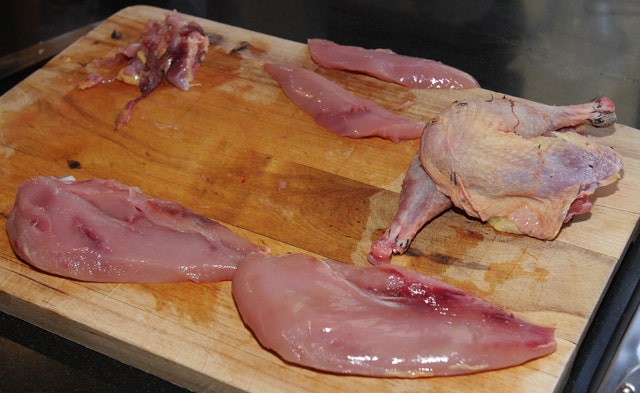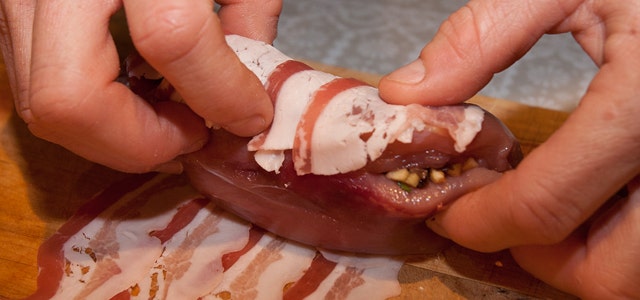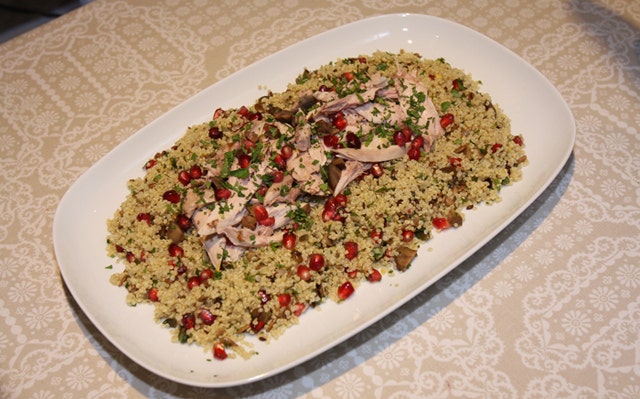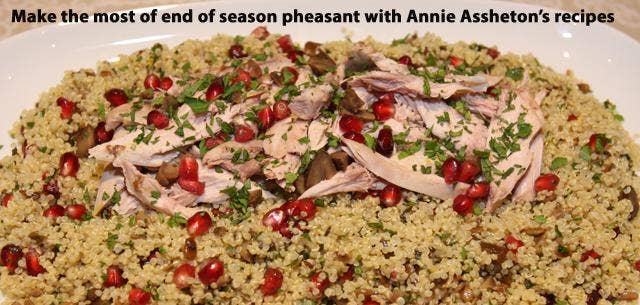Like most game meat, pheasant is extremely versatile and can be enjoyed in so many more ways than the classic roast, wonderful though that may be. A young pheasant quickly roasted and kept well lubricated by frequent basting or by laying strips of streaky bacon over its breasts will be tender and juicy when served very slightly pink.
Trying the same thing with an older bird however will give you a disappointingly tough result and roasting it more thoroughly will only help it dry out. You need to cast around for alternative cooking methods therefore, to be able to enjoy these birds throughout the season.
 A jointed pheasant ready to go, there are so many uses for this wonderful game bird throughout the season.
A jointed pheasant ready to go, there are so many uses for this wonderful game bird throughout the season.Pheasant Curry I often hear people suggesting that with older birds it is only really worth taking off the breasts and discarding everything else. This avoids the need for plucking which I can see might be appealing but I’m appalled at the terrible waste involved. It’s certainly true that the legs, particularly more mature ones, require a little more effort than the breasts but there is so much to be gained from every part of the carcass even if it is just made into a delicious stock to be used either in a soup or as part of a wonderfully rich sauce. Even better though, by braising or casseroling you will get the best out of your older pheasant, breasts and legs alike and there’s no need to limit your options by sticking with more traditional flavour combinations; pheasant meat goes with all sorts of exotic ingredients and works beautifully in curries.
Essentially you could use pheasant as a substitute for chicken in any curry you like but for a simple and delicious pheasant curry pound together some coriander, cumin and dill seeds along with some dried chilli flakes. Separately blitz a couple of fresh chillies, some garlic, fresh ginger and fresh coriander stalks with some oil and lime juice and then combine this paste with the spice mix. You can vary the amounts of each element according to taste and the paste will keep in the fridge for a few days.
Take some pheasant joints and brown them in hot oil until they’re well coloured then add your curry paste and stir over the heat for a few minutes to encourage the spices to release their flavoursome oils. Add coconut milk, bring to the boil, put a lid on the pan and then leave it simmering very gently until the pheasant is cooked through and tender, probably about 45 minutes to an hour.
Finish with a squeeze of lemon juice and some chopped fresh coriander leaves. Of course if you want more instant gratification you could use just breast meat cut into strips for this or other curry recipes, in which case I would fry off the curry paste for a few minutes before browning the meat and then simmer it all for only five minutes or so.
Coq au Vin Coq au Vin with pheasant instead of chicken is another wonderful way to tenderise the meat. Classic recipes like this endure for good reason; it may be old fashioned, bordering on retro even, but I would never be embarrassed to serve this on any occasion. As so often is the case with casserole-type recipes the flavours will only improve after a night or two in the fridge (and it freezes beautifully) so it can be prepared well in advance; perfect when you have guests for the weekend and want to be out and about with them during the day. There are so many recipes for coq au vin I won’t waste my precious space here by spelling it out. Just make sure that once it is submerged in liquid the pheasant is allowed to cook very slowly indeed; anything more than a very gentle simmer is guaranteed to end in disappointing toughness.
Confit Pheasant In the event that you have used your pheasant breasts for a super-quick mid-week supper such as the curry above and are wondering what to do with the left over legs one of my favourite things to have in the freezer is confit pheasant. You can do this in the traditional method using duck or goose fat, as described in my previous article for duck recipes.
When it is ready, rather than keeping it whole and covering it with fat to preserve it, I strip the meat off the bones, discarding those along with the fat, skin and sinews and then finely chop it. Unless I have an immediate use for it I then stick it in the freezer in small batches to be dug out any time I need instant canapés. A spoonful of this finely chopped pheasant confit, seasoned with salt, pepper and some finely chopped flat leaf parsley in a croustade (bought from the supermarket, a sealed pack keeps for ages, never be without one) capped with a blob of a suitable fruit chutney (fig is perfect) and with a short length of chive perched jauntily on top looks gorgeous and tastes sensational.
You could also transform a larger amount of your confit into a punchy sauce for pasta by combining it with a rich tomato sauce and creating a kind of ragu, or for something even more indulgent, warm it through with a splash of brandy or calvados (you could set it alight if you were feeling pyrotechnically minded) and then a generous glug of double cream, plenty of seasoning and some finely chopped sage leaves and let it bubble for a few minutes to reduce before combining with tagliatelle or something similar.
In fact, this is such a useful asset to have in the freezer it may well elevate the legs to being the prime part of the bird and become the first thing you want to do with your several brace of pheasant after a successful shoot, not the last!

Pheasant Breasts with Apples and Cider With the breast meat the possibilities really, are endless; anything you can do with chicken you can do with pheasant. Just be very careful not to over-cook them and aim to serve them very slightly pink.
Having encouraged you to try pheasant with more exotic flavours I do love pairing them with classic English ingredients and apples and cider are wonderful accompaniments. soften some onions and remove them to one side, brown the pheasant breasts then replace the onions and add some chicken stock and cider to the pan along with some sliced or diced apple. Bring it to the boil then put a lid on and allow it to simmer very gently for 15 minutes or less if the breasts are small. Take the breasts out of the pan and let everything bubble to reduce before finishing off with a slug of cream or crème fraiche to bring it all together.
Glorious with a pile of smooth, creamy mashed potato and some curly kale or cavolo nero. You can do a pot roast version of this too, layering some apples on the bottom of an oven proof pan, sitting browned pheasant pieces on top then adding more apple before pouring stock and cider over it all. It can then sit in the oven simmering gently until everything is tender.
Stuffed and Wrapped Pheasant Breasts Stuffing and wrapping pheasant breasts is a good way to keep them juicy and soft. You can either sandwich two breasts together around a filling or cut a pocket in each one and ease the stuffing inside. Either way, wrapping it in streaky bacon not only holds it all together but provides a baste while it’s cooking ensuring it will all stay succulent. You can let your imagination go wild when devising the stuffing; I love a mix of apple, chestnuts and prunes all chopped up finely together with some grated nutmeg and fresh thyme. Pheasant breasts served this way go brilliantly with a creamy celeriac puree and some savoy cabbage or other seasonal leafy greens.
 Rolling stuffed pheasant breasts in streaky bacon, use your imagination for the filling!
Rolling stuffed pheasant breasts in streaky bacon, use your imagination for the filling!My very favourite pheasant recipe is based on a winter salad and is one which combines traditional flavours with those that might be slightly less expected so offers a wonderful mix of the comforting and the inspiring. Quinoa is both hearty enough to fill you up during the colder months but supremely healthy too so you can feel positively smug about eating it. This is an ideal recipe for a winter lunch with friends and a fantastic way of using up any leftover roast pheasant (or other meat) you might have. Having said that it’s delicious enough to make it worth roasting a bird specially.
Winter Salad with Pheasant Serves 4
- 100g quinoa
- 2 tsp vegetable bouillon powder
- 1½ tbsp rapeseed oil
- 40g mixed seeds
- ½ tsp freshly grated nutmeg
- ½ tsp ground cinnamon
- 2 tbsp flatleaf parsley, chopped
- 2 tbsp mint, chopped
- 100g pomegranate seeds
- ½ lemon, zested and juiced
- 50g vacuum-packed chestnuts, sliced
- 300g roast pheasant meat, torn into pieces
Heat ½ tbsp oil in a frying pan and toast the seeds until they take on some colour. Add the nutmeg and cinnamon and cook for a minute or two, stirring regularly. Combine this mix with the quinoa, along with the chopped parsley and mint, most of the pomegranate seeds (reserve a few), the lemon zest and juice, most of the chestnuts (again, reserve a few) and the final tablespoon of oil. Season it all thoroughly with salt and make sure it’s all well combined. Spread this mixture out on a serving plate, top with the pheasant meat and sprinkle over the reserved chestnuts and pomegranate seeds.
Serve with a big, dressed green salad and maybe some bread.

A really good addition to this is some beetroot. You can either roast your own (wrap the whole thing, skin and tops intact in foil and put in a low oven until completely tender then slide the skin off when cool enough) or these days you can buy very good whole cooked beetroot in the supermarket; just make sure it’s not the one with vinegar! Either way, cut the beetroot into eight or so wedges, depending on its size, and fry it off in a bit of butter and a splash of balsamic vinegar before adding to the salad just before the meat.
2016-02-03 11:35:24
233 view(s) 


